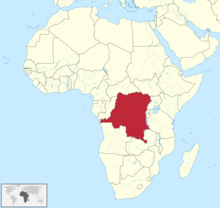| Dwarf water cobra | |
|---|---|

| |
| Scientific classification | |
| Domain: | Eukaryota |
| Kingdom: | Animalia |
| Phylum: | Chordata |
| Class: | Reptilia |
| Order: | Squamata |
| Suborder: | Serpentes |
| Family: | Elapidae |
| Genus: | Naja |
| Subgenus: | Boulengerina |
| Species: | N. nana |
| Binomial name | |
| Naja nana Collet & Trape, 2020 | |

| |
| Distribution of the dwarf water cobra | |
The dwarf water cobra (Naja nana) is a small, venomous species of aquatic cobra found in the Democratic Republic of Congo (Katanga). It was first described by Marcel Collet and Jean-Francois Trape in 2020, based on two specimens from Lake Mai-Ndombe.
Taxonomy
Naja nana is classified under the genus Naja of the family Elapidae, and considered a member of the Boulengerina subgenus, along with related species such as Naja annulata, Naja christyi, and Naja melanoleuca. The genus name Naja is a Latinisation of the Sanskrit word nāgá (नाग), meaning "cobra”; the species name nana derives from the Latin word, nanus, which means feminine, in reference to its small size.
Description
The dwarf water cobra typically doesn't grow longer than 1 m (3.3 ft), unlike the two other semiaquatic African Naja species, Naja annulata and Naja christyi, both of which can attain lengths of up to about 2.5 m (8.2 ft).
Distinguishing features of the species include its characteristic defensive posture, its aquatic lifestyle, the straight-row arrangement of its dorsal scales, and its distinctive coloration: black with small white or yellowish spots, a whitish abdomen, and a black underside of the tail.
The eggs of the dwarf water cobra are large and elongated, and require 70 days of incubation to hatch.
Behavior
Dwarf water cobras can swim and climb, but generally prefer a terrestrial habitat, although they will hunt and defecate in water when able. In the wild they are exclusively piscivorous, although in captivity they are often fed a rodent-based diet. One case of cannibalism of a conspecific snake is known.
References
- ^ Uetz, P; Hallermann, J. "Naja nana COLLET & TRAPE, 2020". Reptile Database. Retrieved 31 October 2021.
- Trape, J.F; Collet, M (2020). "A new and remarkable species of semi-aquatic naja (Elapidae, subgenus Boulengerina Dollo, 1886) from the Democratic Republic of Congo". Bulletin de la Société Herpétologique de France. 173: 41–52. Archived from the original on 8 March 2018. Retrieved 31 October 2021.
- ^ Spawls, S; Howell, K; Hinkel, H; Menegon, M (27 March 2018). A Field Guide to East African Reptiles (2 ed.). London: Bloomsbury Natural History. p. 624. ISBN 978-1472935618. Retrieved 31 October 2021.
- Raw, LR; Deacon, R (27 June 2021). "Two additional specimens of Naja (Boulengerina) nana (Serpentes: Elapidae) with notes on captive husbandry and behaviour". Occasional Papers in Zoology. 9: 1–8. doi:10.5281/zenodo.5103417. Retrieved 31 October 2021.
- ^ Raw, LR; Deacon, R (27 June 2021). "Two additional specimens of Naja (Boulengerina) nana (Serpentes: Elapidae) with notes on captive husbandry and behaviour". Occasional Papers in Zoology. 9: 1–8. doi:10.5281/zenodo.5103417. Retrieved 31 October 2021.
- Chippaux, J.P; Jackson, K (18 June 2019). Snakes of Central and Western Africa. United States: Johns Hopkins University Press. p. 448. ISBN 978-1421427195.
| Taxon identifiers | |
|---|---|
| Naja nana | |